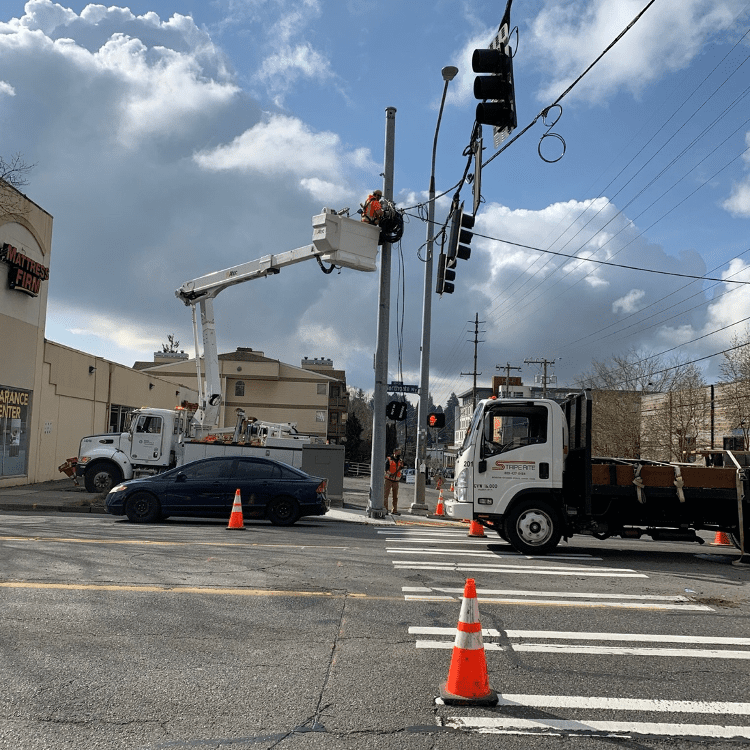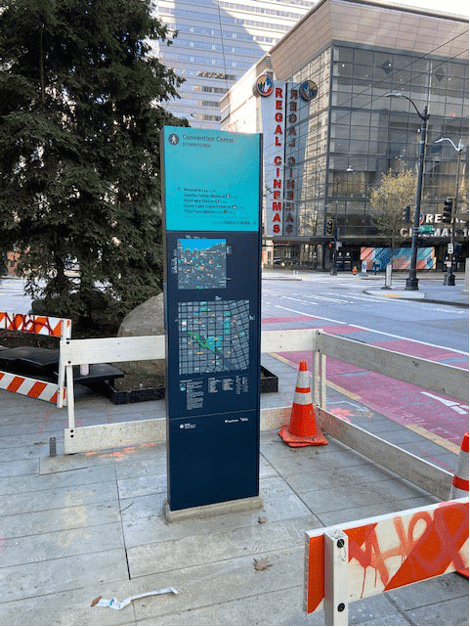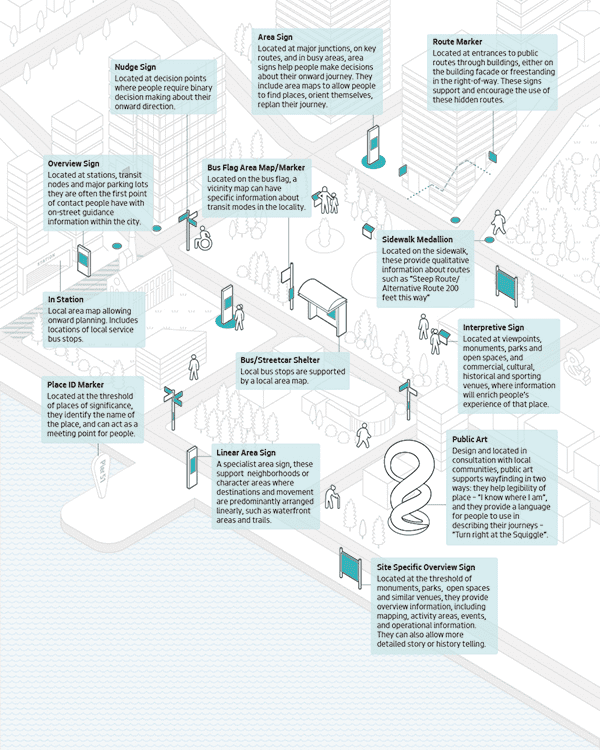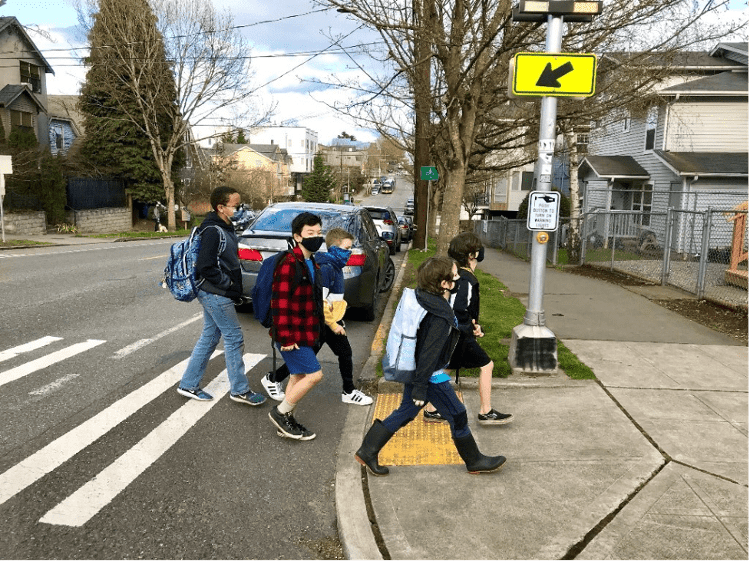 Crews working on signal upgrades at the intersection of 8th Ave NE and NE Northgate Way. Photo: SDOT
Crews working on signal upgrades at the intersection of 8th Ave NE and NE Northgate Way. Photo: SDOT In this SDOT Best of the Month, we’ll highlight some of the projects that made news in April – and some that didn’t.
- Our wayfinding program, Seamless Seattle, is the result of years of planning and partnerships.
- We installed a new traffic signal at 8th Ave NE and NE Northgate Way using something called a TOUP contract (more on that below!). This will make the intersection safer for people walking, rolling, and biking.
- We’re part of a University of Washington Urban Freight Lab case study to reduce traffic and emissions in Belltown.
- We’ve been working with Seattle Public Schools to make sure that kids and families can safely return to in-person school.
- Together with Seattle Parks and Recreation, we’re redesigning the Magnuson Park entrance and adding new sidewalks on Sand Point Way to make the area safer for residents and visitors to the park.
Our crews work around the clock, around the city, to keep you moving safely. Here are a few big accomplishments that didn’t make it into our blog this month.
We rely on partnerships to make important safety improvements across the city.
Have you seen the new maps popping up around downtown?
This is part of Seamless Seattle, the city’s new pedestrian wayfinding program!
The City of Seattle has committed to increasing the percentage of trips made by walking to 35% by 2035. Developing a coordinated pedestrian wayfinding system is one strategy to achieve this goal by making it easier to walk and use transit in Seattle.

Wayfinding is about how we navigate places (think about it as “finding” your “way”!). Wayfinding projects create information to help everyone navigate cities more easily. Usually, the most visible part of a wayfinding system is signage, which can include graphics, printed maps, apps, public art, and other landmarks. All in all, a wayfinding system is another information layer to provide the support people need, when they need it, in an appropriate form for their situation and abilities. It supports more equitable access to the public realm and local amenities.
The Seamless Seattle wayfinding program is the result of years of partnerships and engagement with people and organizations close to home. We drew inspiration from London, New York City, and Vancouver, B.C. as we worked with consultant team Applied Wayfinding, which helped design wayfinding programs in those cities.

We extend our gratitude to all the SDOT staff and crews who have been involved for their hard work and true craftsmanship in getting these installed! As downtown slowly becomes a busier area for residents and visitors alike, we look forward to supporting everyone as they explore Seattle.
This is the start of much more. Over the next few months, we’ll be sharing more about our progress on this wayfinding program and what you can expect to see next.
We recently worked with a Task Order Unit Price (TOUP) contractor to construct a new signal at the intersection of 8th Ave NE and NE Northgate Way to improve safety for people walking, rolling, and biking.

The intersection of 8th Ave NE and NE Northgate Way is located in the Northgate Urban Center and along the future Pinehurst Connection Neighborhood Greenway. Neighborhood greenways are safer, calmer residential streets for you, your family, and neighbors, made possible by your investment in the Levy to Move Seattle.
The Pinehurst Connection Neighborhood Greenway on 8th Ave NE and NE 117th St originated in the City’s Bike Master Plan. This neighborhood greenway provides a prioritized walking, rolling, and biking connection between Pinehurst, Northgate, and Maple Leaf. We worked closely with neighbors to determine the neighborhood greenway route and design crossing improvements along the route.
This neighborhood greenway connects residents to local schools, parks, and businesses as well as the citywide transportation network. The upgrade at this intersection will also help people cross NE Northgate Way in time for the opening of Northgate Link light rail station in October! The changes include a new protected bike crossing, new protected left turns, and a new signalized crosswalk on the west side of the intersection.
Normally, this type of upgrade requires a considerable amount of coordination between multiple SDOT crews and teams. For this project, we worked with a TOUP contract to design and perform the work.
The TOUP contract is one of the 12 different ways that contractors help us get work done. The TOUP contract helps us make progress on and finish important projects when our crews already have a heavy workload. This supports us in meeting our Levy to Move Seattle goals (P.S. Click here to see how we’ve been putting your tax dollars to work so far in 2021!). This contract is also a way for us to support women and minority-owned businesses and work with firms that have been historically underutilized in contracting.
SDOT teams had designed 90% of the project when the contractor came onboard. The contractor constructed all of the traffic signal infrastructure with our design plans. The contractor also rebuilt and restored the sidewalks and curb ramps and installed ADA accessible pedestrian push buttons. These improvements will help keep people safe at the intersection.
Our crews then completed the remaining electrical work, activated the new signal, and painted the crosswalk. This first-time partnership helped us make important safety improvements more quickly and at a lower cost, saving time and resources. We are looking forward to more opportunities to coordinate between contractors and SDOT crews!
In case you missed it on the blog this month: we’re collaborating with the University of Washington and City departments to reduce traffic and emissions and improve safety for kids and families.

We’re working with Seattle Public Schools to keep families safe as in-person schooling returns with new “School Streets,” where most cars are not allowed.
Students headed back to their classrooms this month as Seattle Public Schools transitioned to in-person learning. Stay Healthy Streets and new “School Streets” in front of schools are open to people walking, rolling, and biking, and closed to most cars. During the pandemic, we’ve completed about 20 Safe Routes to School projects to increase safety for people walking, rolling, and biking near schools. Read more here.
We’re taking part in UW Urban Freight Lab’s Belltown study, which is working to identify solutions for easier deliveries and cleaner air in Seattle.
The study is looking at eight blocks of the Belltown neighborhood to better understand current delivery patterns and help make them more efficient and less polluting. The Belltown study is a three-year $1.5M project led by the University of Washington’s Urban Freight Lab and funded by the U.S. Department of Energy’s Office of Energy Efficiency and Renewable Energy to develop technologies to reduce fuel consumption in the urban goods delivery system. Read more here.
Our partnership with Seattle Parks and Recreation will help people get in and out of Magnuson Park more safely.
We’re making changes near Magnuson Park to keep people safe, whether they are walking, rolling, biking, driving, or taking transit. We’re adding new sidewalks, reconfiguring intersections, making signal timing upgrades, and more. Part of this work includes a redesigned park entrance and new sidewalks to provide a link to walking, rolling, biking, and transit options for the Sand Point community. Your investment through the Levy to Move Seattle, as well as funding from Seattle Children’s Hospital, makes this work possible! Read more here.